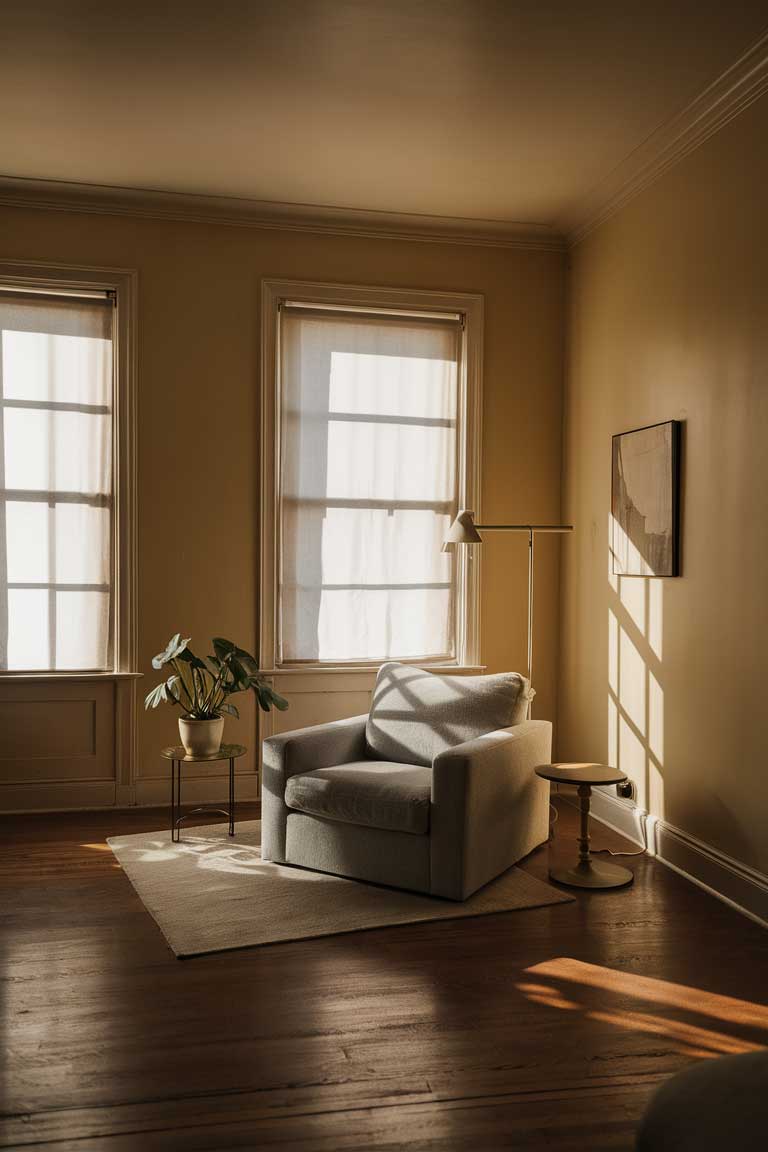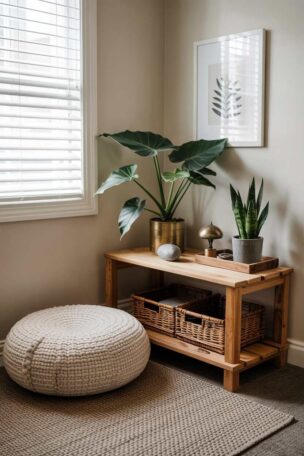In our fast-paced, consumer-driven world, the concept of minimalism has gained traction as a refreshing alternative to the constant pursuit of more. But what exactly is minimalism? At its core, it’s a lifestyle that focuses on simplicity, intentionality, and removing excess in all areas of life. It’s not about living with nothing—it’s about living with just enough.
Embracing minimalism can lead to a host of benefits. You might find yourself with more time, more money, and less stress. Many minimalists report feeling a greater sense of freedom and clarity in their daily lives. By letting go of the unnecessary, you create space for what truly matters.
Now, let’s dive into the practical ways you can incorporate minimalism into your life, starting with your living space.
Decluttering Your Home
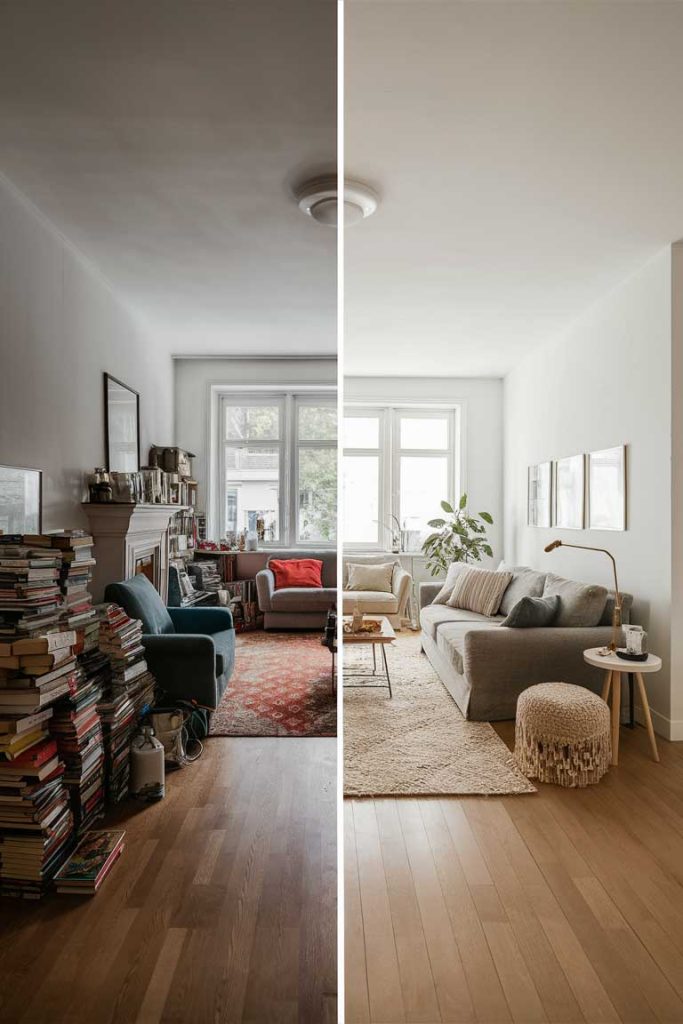
1. Start Small: Remove One Item
The journey of a thousand miles begins with a single step, and your minimalist journey can start with removing just one item from your home. It might seem insignificant, but this small action sets the wheels in motion. Maybe it’s that novelty mug you never use or the outdated magazine sitting on your coffee table. Whatever it is, let it go and feel the subtle shift in your environment.
2. Assess Necessity and Joy
As you continue decluttering, ask yourself two key questions about each item: “Is this necessary?” and “Does this bring me joy?” If the answer to both is no, it’s time to bid farewell. This process, popularized by Marie Kondo, helps you curate a home filled only with items that serve a purpose or spark happiness.
Remember, what’s necessary or joyful for you might be different from someone else. Your childhood teddy bear might seem unnecessary to others, but if it brings you joy, it has earned its place in your minimalist home.
3. Implement a Regular Decluttering Schedule
Decluttering isn’t a one-and-done deal—it’s an ongoing process. Set up a regular schedule to maintain your minimalist space. Many find success with seasonal decluttering, tackling different areas of their home every three months. Others prefer monthly maintenance sessions. Find what works for you and stick to it.
Pro tip: Mark these decluttering sessions in your calendar like any other important appointment. Treat them as non-negotiable time dedicated to maintaining your peaceful space.
Simplifying Your Wardrobe
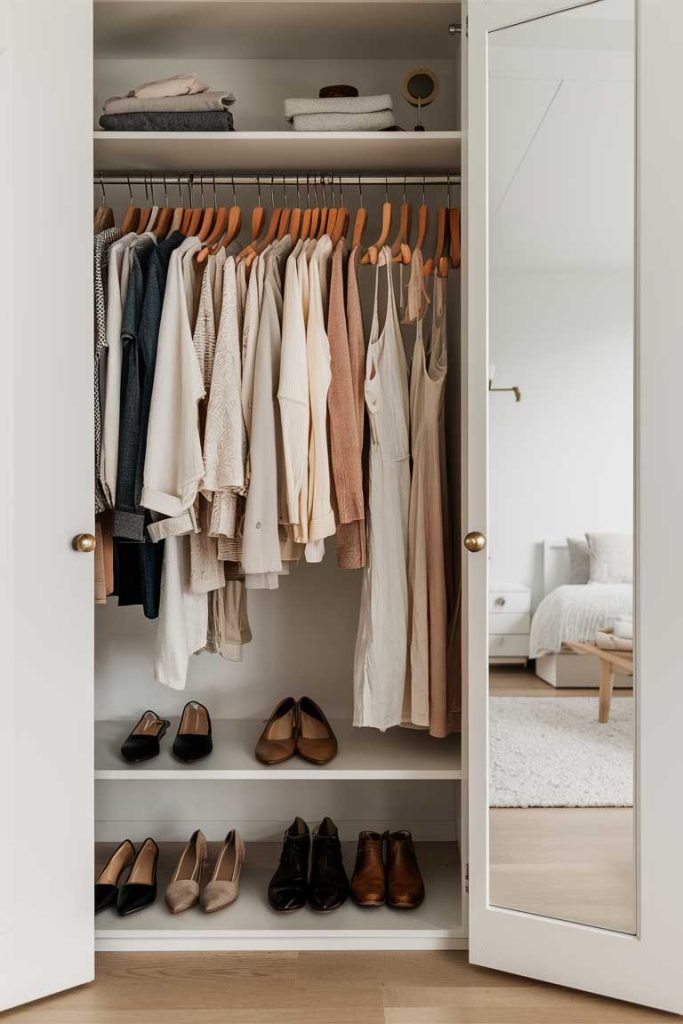
4. Build a Capsule Wardrobe
A capsule wardrobe is a minimalist’s secret weapon against closet chaos. It’s a small collection of versatile pieces that can be mixed and matched to create numerous outfits. Think quality over quantity here.
Start by selecting a color palette that suits you. Choose a base color (like black, navy, or beige) and add 1-2 accent colors. Then, aim for about 30-40 pieces total, including:
- 5-7 tops
- 3-4 bottoms
- 1-2 dresses
- 2-3 pairs of shoes
- 1-2 jackets or coats
- A few accessories
Remember, these numbers are just guidelines. Adjust based on your lifestyle and needs.
5. Invest in Quality Over Quantity
When building your minimalist wardrobe, focus on high-quality pieces that will stand the test of time. Yes, they might cost more upfront, but they’ll save you money in the long run by lasting longer and looking better.
Look for natural fabrics like cotton, wool, and silk, which tend to be more durable and age better than synthetics. Check the construction of garments—reinforced seams and sturdy buttons are good signs of quality. And don’t forget about versatility—choose pieces that can be dressed up or down for different occasions.
6. Embrace Your Favorites
We all have those outfits that make us feel like a million bucks. In a minimalist wardrobe, every piece should give you that feeling. Start wearing your favorite outfits more often. If you’re hesitant because you’re “saving” them for special occasions, ask yourself: isn’t every day special enough to feel your best?
Try this mental exercise: Imagine if you could only wear your absolute favorite outfits every day. Which pieces would make the cut? This can help you identify the true stars of your wardrobe and let go of the rest.
Managing Finances and Subscriptions
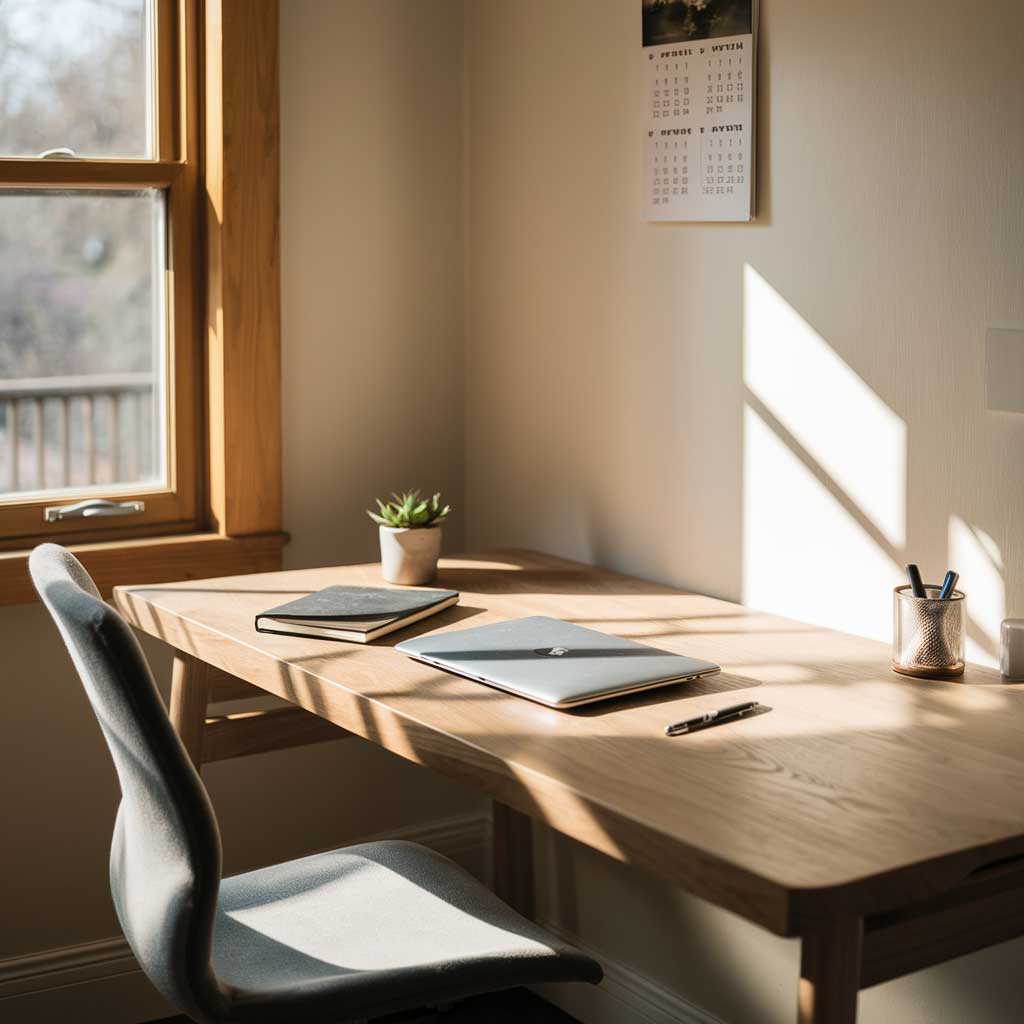
7. Create a Minimalist Budget
A minimalist approach to finances starts with a clear understanding of your needs versus your wants. Create a budget that prioritizes necessities like housing, food, and healthcare. Then, critically evaluate your “wants” category. Do you really need that streaming service you barely use? Could you cut back on dining out?
One effective strategy is the 50/30/20 rule: allocate 50% of your income to needs, 30% to wants, and 20% to savings and debt repayment. This simple framework can help you maintain financial stability while still allowing for some indulgences.
8. Avoid Impulse Purchases
In our world of one-click ordering and targeted ads, impulse buying is easier than ever. Combat this by implementing a one-week rule: When you want to buy something non-essential, wait one week before making the purchase. Often, you’ll find the urge passes.
During that week, ask yourself:
- Will I still want this a year from now?
- How many hours of work does this cost me?
- Do I have something similar already?
- Can I borrow this instead of buying it?
These questions can help put the purchase in perspective and curb unnecessary spending.
9. Audit and Manage Subscriptions
Subscriptions can be sneaky budget-busters. Many of us sign up for free trials and forget to cancel or keep subscriptions we rarely use out of habit. Take time to audit all your subscriptions—streaming services, gym memberships, subscription boxes, etc.
For each one, ask:
- How often do I use this?
- Does it provide value equal to or greater than its cost?
- Is there a free or cheaper alternative?
Use apps like Truebill or Mint to track and manage your subscriptions. They can help you identify forgotten subscriptions and even cancel them on your behalf.
Reducing Technology Use

10. Minimize Digital Distractions
Our phones and computers, while incredibly useful, can also be major sources of distraction. Start by turning off non-essential notifications. Do you need to know immediately whenever someone likes your Instagram post?
On your phone, go to Settings > Notifications and review each app. Turn off notifications for social media, games, and any apps that aren’t crucial for your daily life or work. On your computer, disable pop-up notifications for email and messaging apps during focused work time.
11. Monitor and Limit Screen Time
Most smartphones now have built-in screen time tracking. Check yours regularly to get a reality check on how much time you’re spending on your device. Set daily limits for social media apps and overall screen time.
Apps like Freedom or Forest can help you stick to these limits by blocking distracting apps or websites during set times. Start small—maybe limit social media to 30 minutes a day—and gradually decrease as you become more comfortable with less screen time.
12. Create Tech-Free Zones and Times
Designate certain areas of your home as tech-free zones. The dinner table and bedroom are great places to start. Having physical spaces free from the constant ping of notifications can help you be more present and relaxed.
Implement a nightly tech curfew, too. Try putting away all screens at least an hour before bedtime. This not only reduces distractions but can also improve your sleep quality, as the blue light from screens can interfere with your body’s natural sleep-wake cycle.
Embracing a Minimalist Mindset

13. Adopt a Gradual Approach
Minimalism isn’t about making drastic changes overnight. It’s a journey, and it’s okay to take it one step at a time. Try daily micro-challenges: remove one unnecessary item from your home each day, or clear one surface before you go to bed.
Keep track of the money you save by not buying non-essentials. Watching this “minimalism fund” grow can be a great motivator to continue your journey.
14. Eliminate Unnecessary Obligations
Take a hard look at your commitments. Are you involved in activities that no longer bring you joy or align with your values? It’s okay to step back from these.
Learning to say “no” is a crucial skill for minimalists. When invited to events or asked to take on new responsibilities, pause before automatically saying yes. Consider whether it aligns with your priorities and if you truly have the time and energy for it.
15. Find Inspiration and Resources
Stay motivated on your minimalist journey by seeking out inspiration and like-minded individuals. Follow minimalist bloggers, read books on the subject, or watch documentaries about simple living.
Some recommendations:
- Blogs: The Minimalists, Becoming Minimalist
- Books: “The Life-Changing Magic of Tidying Up” by Marie Kondo, “Goodbye, Things” by Fumio Sasaki
- Documentaries: “Minimalism: A Documentary About the Important Things,” “The True Cost”
Join online communities or local groups focused on minimalism. Sharing experiences and tips with others can provide support and fresh ideas for your journey.
Incorporating Minimalist Habits into Daily Routines

16. Morning Routine
Start your day with intention by creating a simple, minimalist morning routine. This could include:
- Wake up without checking your phone
- Spend 5 minutes in quiet reflection or meditation
- Do some light stretching or yoga
- Enjoy a simple breakfast without distractions
- Review your priorities for the day
This 15-20 minute routine can set a calm, focused tone for your entire day.
17. Mindful Spending Practices
Incorporate the one-week waiting period for purchases into your daily life. Keep a wish list of items you want, but don’t buy anything immediately. After a week, reassess if you still want or need the item.
Create a values-based budget that aligns with your minimalist principles. Regularly review your spending to ensure it matches your values and priorities.
18. Digital Minimalism Habits
Make digital decluttering a daily habit. Unsubscribe from one email list each day, delete unused apps, or clear out old files and photos. These small actions can significantly reduce digital clutter over time.
Stick to your screen time limits. If you find yourself reaching for your phone out of habit, have alternative activities ready—keep a book handy or use that time for a quick walk or stretch.
19. Mindfulness and Gratitude Practices
End each day with a 5-minute gratitude journaling session. Write down three things you’re grateful for—this simple practice can shift your focus from what you lack to what you have.
Incorporate brief mindfulness moments throughout your day. Take three deep breaths before starting a new task, or pause to notice your surroundings during your commute.
20. Simplifying Daily Tasks
Adopt a “clean as you go” mentality in all areas of life. In the kitchen, wash dishes immediately after use. In your workspace, file papers and clear your desk at the end of each day. These small habits prevent clutter from accumulating and save time in the long run.
Simplify meal planning by creating a rotating menu of favorite meals. This reduces decision fatigue and makes grocery shopping more efficient. Prep ingredients in advance to streamline weeknight cooking.
Conclusion
Living a minimalist life is about more than just owning less stuff—it’s a mindset that prioritizes intentionality, simplicity, and focus on what truly matters. By decluttering your space, simplifying your wardrobe, managing your finances mindfully, reducing technology use, and embracing minimalist habits, you can create a life with less stress and more meaning.
Remember, minimalism looks different for everyone. There’s no one-size-fits-all approach. Start small, be patient with yourself, and focus on the areas that will have the most significant impact on your life. The goal isn’t perfection but progress towards a more intentional way of living.
As you embark on this journey, you may find that by letting go of the excess, you’re actually gaining something invaluable—space for what truly matters in your life. So take that first step, remove that first item, and see where the path of minimalism leads you. You might be surprised at how liberating it can be to live with less.

